High Impact Tutoring Built By Math Experts
Personalized standards-aligned one-on-one math tutoring for schools and districts
In order to access this I need to be confident with:
Circle math Circumference of a circle Solving equations Law of sines Law of cosines Rounding Square root FactoringArc length formula
Here you will learn about the arc length formula, including how to identify the arc of a circle (minor and major), form and use the arc length formula to calculate arc length, and calculate the arc length in various scenarios.
Students will first learn about the arc length formula as part of geometry in high school.
What is the arc length formula?
The arc length formula is used to calculate the length of the curved segment, called an arc, along the circumference of a circle or curve. The arc length is a portion of the circumference of the circle.

Major arc: greater than half the circumference
Minor arc: less than half the circumference

In order to calculate the arc length, you need to know the circumference of the circle. The portion of the circle’s circumference that the arc length represents is determined by the angle created by the two radii.

The sum of the angle around a point is equal to 360^{\circ}, therefore, the arc length is the fraction of the circle’s circumference created by the sector.
The angle is out of 360 or \cfrac{\theta}{360}, where \theta (theta) represents the central angle, so you multiply this by the circumference to calculate the arc length.
Therefore, to calculate the arc length, you use the following formula (the arc length formula):
\text{Arc Length}=\cfrac{\theta}{360}\times\pi\times{d}
\theta – angle of the sector
d – diameter of the circle
\text{Arc length}=\cfrac{\theta}{360}\times2\times\pi\times{r}
\theta – angle of the sector
r- radius of the circle
What is the arc length formula?
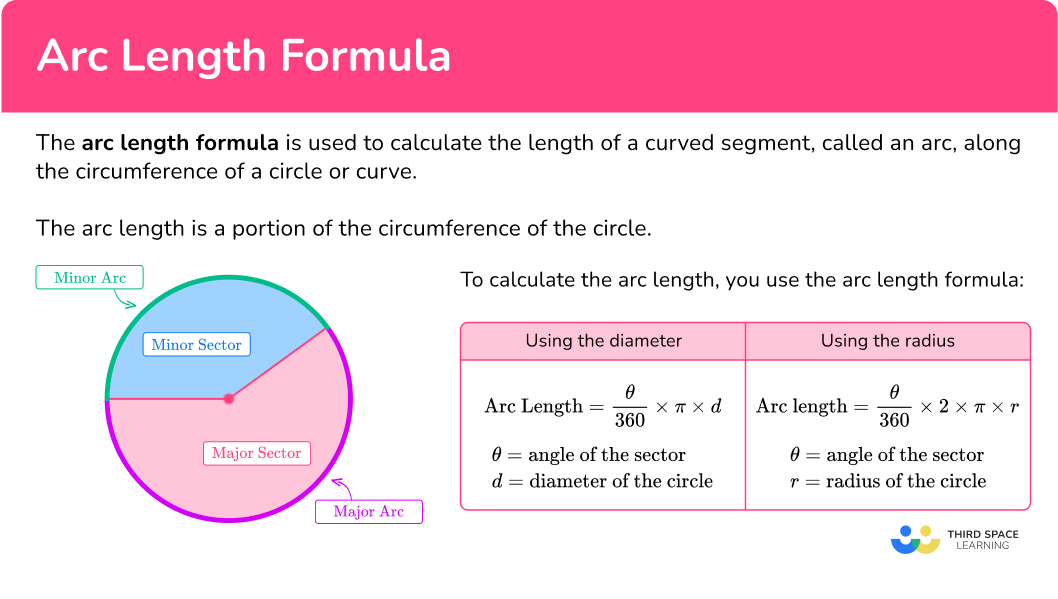
Common Core State Standards
How does this relate to high school math?
- High School – Geometry – Circles (HS.G.C.B.5)
Derive using similarity the fact that the length of the arc intercepted by an angle is proportional to the radius, and define the radian measure of the angle as the constant of proportionality; derive the formula for the area of a sector.
![[FREE] Common Core Practice Tests (Grades 3 to 6)](https://thirdspacelearning.com/wp-content/uploads/2023/10/common-core-practice-tests.png)
[FREE] Common Core Practice Tests (Grades 3 to 6)
![[FREE] Common Core Practice Tests (Grades 3 to 6)](https://thirdspacelearning.com/wp-content/uploads/2023/10/common-core-practice-tests.png)
Prepare for math tests in your state with these Grade 3 to Grade 6 practice assessments for Common Core and state equivalents. 40 multiple choice questions and detailed answers to support test prep, created by US math experts covering a range of topics!
DOWNLOAD FREE![[FREE] Common Core Practice Tests (Grades 3 to 6)](https://thirdspacelearning.com/wp-content/uploads/2023/10/common-core-practice-tests.png)
[FREE] Common Core Practice Tests (Grades 3 to 6)
![[FREE] Common Core Practice Tests (Grades 3 to 6)](https://thirdspacelearning.com/wp-content/uploads/2023/10/common-core-practice-tests.png)
Prepare for math tests in your state with these Grade 3 to Grade 6 practice assessments for Common Core and state equivalents. 40 multiple choice questions and detailed answers to support test prep, created by US math experts covering a range of topics!
DOWNLOAD FREEHow to calculate the arc length using the arc length formula
In order to calculate the arc length:
- Find the length of the radius/diameter.
- Find the size of the angle creating the arc of the sector.
- Substitute the values you know into the arc length formula.
- Calculate the answer.
Arc length formula examples
Example 1: calculate the arc length (quadrant)
Calculate the arc length of the sector shown below.
Give your answer to the nearest thousandth.

- Find the length of the radius/diameter.
The radius of a circle is the length of the line segment from the center of the circle to the circumference. Here the radius r=6 \, cm.
2Find the size of the angle creating the arc of the sector.
Angle: \theta=90^{\circ} (shown by the symbol of the right angle).
3Substitute the values you know into the arc length formula.
As you know the radius, you can use the formula that has ‘r’ as a variable.
\text{Arc length}=\cfrac{\theta}{360}\times{2}\times\pi\times{r}Substituting \theta=90^{\circ} and r=6\mathrm{~cm} into the formula:
\begin{aligned}\text{Arc length}&=\cfrac{90}{360}\times{2}\times\pi\times{6} \\\\ &=3\pi \end{aligned}4Calculate the answer.
The question asked you to round your answer to the nearest thousandth.
\text{Arc length}=3\pi=9.425\mathrm{~cm}Remember, the arc length (length of a curve on the circumference) is a measure of distance, and therefore the units are not squared.
Example 2: calculate the arc length (semicircle)
Calculate the arc length of the semicircle shown below.
Give your answer in terms of \pi.
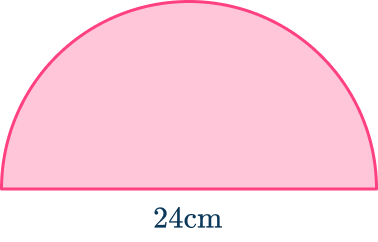
Find the length of the radius/diameter.
Diameter: d=24\mathrm{~cm}
Find the size of the angle creating the arc of the sector.
Angle \theta=180^{\circ}. This is because the shape shown is a semicircle, so the angle of the straight line is 180 degrees.
Substitute the values you know into the arc length formula.
As you know the radius, you can use the formula that has ‘d’ as a variable.
\text{Arc length}=\cfrac{\theta}{360}\times\pi\times{d}
Substituting \theta=180^{\circ} and d=24\mathrm{~cm} into the formula:
Clearly state your answer.
The question asked you to give your answer in terms of \pi.
\text{Arc length}=12\pi\mathrm{~cm}
Example 3: calculate the arc length (with an angle given)
Calculate the arc length of the sector shown below.
Give your answer to the nearest tenth.
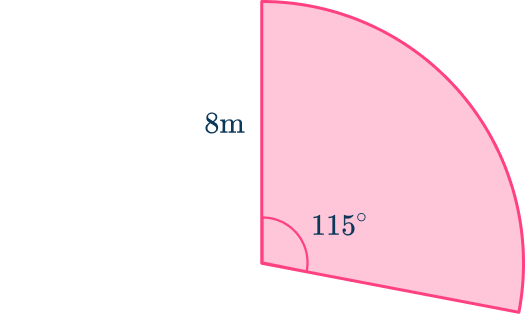
Find the length of the radius/diameter.
Radius: r=8\mathrm{~m}
Find the size of the angle creating the sector.
Angle \theta=115^{\circ}
Substitute the values you know into the arc length formula.
As you know the radius, you can use the formula that has ‘r’ as a variable.
\text{Arc length}=\cfrac{\theta}{360}\times{2}\times\pi\times{r}
Substituting \theta=115^{\circ} and r=8\mathrm{~m} into the formula:
Calculate the answer.
The question asked you to round your answer to the nearest tenth.
\text{Arc length}=\cfrac{46}{9}\pi=16.1\mathrm{~m}
Example 4: calculate the arc length (the angle is not given)
AOB is a sector of a circle.
The length of the radius (OB) is 9\mathrm{~cm}.
The length of a chord (AB) is 10\mathrm{~cm}.
Calculate the arc length of AOB below.
Give your answer to the nearest hundredth.
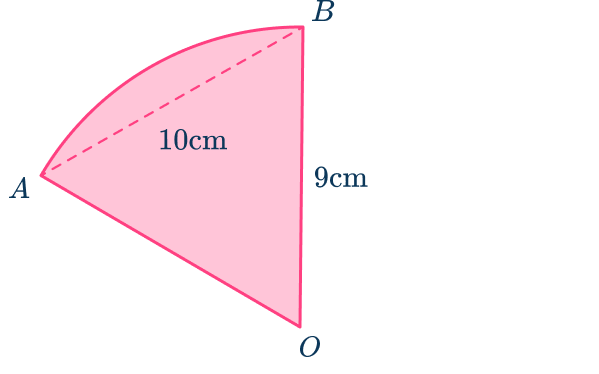
Find the length of the radius.
Radius: r=9\mathrm{~cm}
Find the size of the angle creating the sector.
In this example, you are not given the angle of the sector; you need to calculate it first. Here, you can use the triangle created by the two radii and the chord to find the angle.
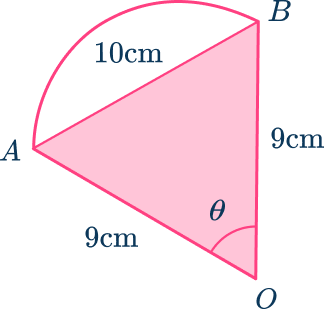
In this example, you need to apply the cosine rule to find the angle.
a^2=b^2+c^2-2bc\cos(A)
A is the angle you are trying to find, labeled \theta. You can therefore use the rearranged cosine rule to find the angle.
\cos(A)=\cfrac{b^{2}+c^{2}-a^{2}}{2bc}
As A=\theta, a=10\mathrm{~cm}, b=9\mathrm{~cm}, and c=9\mathrm{~cm}
The size of the angle creating the sector is 67.5^{\circ}
Substitute the values you know into the arc length formula.
As you know the radius, you can use the formula that has ‘r’ as a variable.
\text{Arc length}=\cfrac{\theta}{360}\times{2}\times\pi\times{r}
Substituting \theta=67.5^{\circ} and r=9\mathrm{~cm} into the formula:
Calculate the answer.
The question asked you to round your answer to the nearest hundredth.
\text{Arc length}=\cfrac{27}{8}\pi=10.60\mathrm{~cm}
How to solve problems using the arc length formula
In order to determine missing angle or radius given the area of a sector:
- Clearly state which of the properties you know (radius / angle of sector, arc length).
- Substitute known values into the formula for the arc length.
- Solve for the unknown value.
Example 5: finding the radius given the arc length of the sector
The sector below has an arc length of 20\mathrm{~cm} and an angle of 125^{\circ}.
Calculate the length of x.
Give your answer to the nearest hundredth.
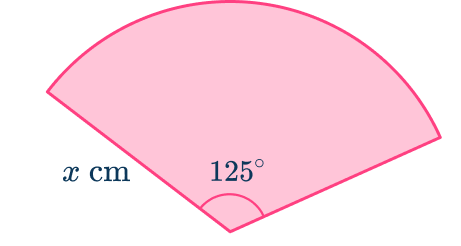
Clearly state which of the properties you know (radius / angle of sector, arc length).
Radius: r=x\mathrm{~cm}
Angle of sector: \theta=125^{\circ}
Arc length: L=20\mathrm{~cm}
Substitute known values into the formula for the arc length.
As you are finding the radius, use the formula that has ‘r’ as a variable.
\text{Arc length}=\cfrac{\theta}{360}\times{2}\times\pi\times{r}
Substituting r=x\mathrm{~cm},~\theta=125^{\circ} and arc length L=20\mathrm{~cm} into the formula:
20=\cfrac{125}{360}\times{2}\times\pi\times{x}
Solve for the unknown value.
Simplify the fraction first.
20=\cfrac{25}{36}\times\pi\times{x}
Divide each side of the equation by the fraction.
\cfrac{144}{5}=\pi\times{x}
Divide each side of the equation by \pi .
Example 6: finding the angle of a sector given the arc length
The sector below has an arc length of 62\mathrm{~cm} and a radius of 18.5.
Calculate the length of x.
Give your answer to the nearest hundredth.
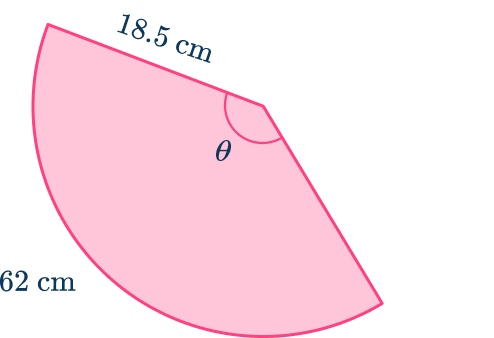
Clearly state which of the properties you know (radius / angle of sector, arc length).
Radius: r=18.5\mathrm{~cm}
Angle of sector: \theta
Arc length: L=62\mathrm{cm}
Substitute known values into the formula for the arc length.
As you know the radius, you can use the formula that has ‘r’ as a variable.
\text{Arc length}=\cfrac{\theta}{360}\times{2}\times\pi\times{r}
Substituting \theta,~r=18.5\mathrm{~cm} and arc length L=62\mathrm{~cm} into the formula:
62=\cfrac{\theta}{360}\times{2}\times\pi\times{18.5}
Clearly state your answer.
Divide both sides by 18.5 .
\cfrac{62}{18.5}=\cfrac{\theta}{360}\times{2}\times\pi
Divide both sides by 2\pi .
\cfrac{62}{37\pi}=\cfrac{\theta}{360}
Multiply both sides by 360 .
\theta=192.0182881…
The question asked you to round your answer to the nearest hundredth.
\theta=192.02^{\circ}\text{ (2dp)}
Teaching tips for arc length formula
- Ensure study materials have clearly drawn diagrams of circles, with the radius, central angle, and arc labeled.
- Discuss real-life examples like sections of a track, slices of pie, or the edge of a clock.
- For advanced students, connect arc length calculations to trigonometry by linking them to trigonometric functions and unit circle concepts. You can also connect arc length to calculus by introducing the derivative concept for finding arc length in more complex curves.
- Explain how great circle distances on Earth’s surface represent arcs. Discuss how the central angle corresponds to the latitude or longitude difference between two points.
- Utilize geometry software or online tools where students can manipulate the circle’s radius and central angle to see how the arc length changes. Students can also utilize online circle calculators.
Easy mistakes to make
- Finding the length of the circumference, not the length of an arc
Remember to find the fraction of the circle that makes the arc not just the circumference of the whole circle.
For example, use \cfrac{\theta}{360}\times\pi\times{d} or \cfrac{\theta}{360}\times2\times\pi\times{r}, not \pi\times{d} or 2\times\pi\times{r}.
- Incorrect use of the cosine rule
Many mistakes are made when applying other rules within an arc question such as the cosine rule. Take your time and regularly ask if your answer makes sense within the context of the question.
- Incorrect units
Remember the arc is a length and therefore the units will not be squared.
Related sectors, arcs and segments of a circle lessons
Practice arc length formula questions
1. The circumference of a circle is 24\mathrm{~cm}. A sector within the same circle creates an arc of 6\mathrm{~cm}. What is the angle of the sector?




The arc length of a sector is a fraction of the total circumference of the circle.
\cfrac{\text{Arc length}}{\text{Circumference}}=\cfrac{6}{24}=\cfrac{1}{4}.
A quarter of a circle has an angle of 360\times\cfrac{1}{4}=90^{\circ}.
2. What type of arc is made by the sector in question 1?
Major arc

Minor arc

Straight arc

Acute arc

The arc length is less than half the circumference. It is therefore a minor arc.
3. Calculate the arc length of this sector, in terms of \pi.





4. Calculate the arc length of this semicircle in terms of \pi.
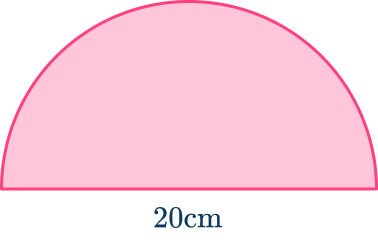




5. Calculate the arc length of this sector. Write your answer to the nearest tenth.
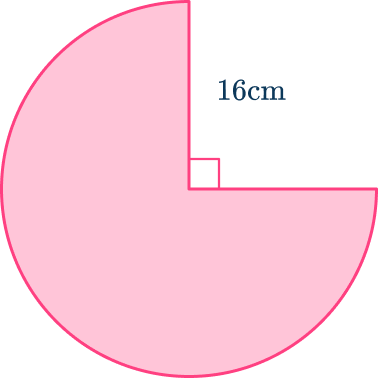




6. The arc length of a sector is 4.8\mathrm{~cm}. The radius of the sector is 3.2\mathrm{~cm}. Determine the angle of the sector to the nearest integer.




Arc length formula FAQs
The arc length formula is \text{ Arc length } \cfrac{\theta}{360}\times{2}\times\pi\times{r} where \theta is the central angle in degrees and r is the radius of the circle.
The arc length measures the distance along the curved part of the sector, while the sector area measures the entire space within the sector (both the curvature and the triangular part formed by the radii).
Arc length is the length of the curved segment of the circumference between two endpoints on a circle, while chord length is the straight line distance between those two endpoints.
Finding the arc length of a circle typically involves using geometric formulas based on the radius and central angle, while finding the arc length of a curve requires calculus techniques, specifically integration, involving the function representing the curve and its derivative.
Yes, the arc length formula involving definite integrals can be used for any curved line, not just circles. The general formula is used to find the length of curves described by functions.
In summary, while both involve finding the length of a segment along a curve, the arc length of a circle relies on geometry, while the arc length of a function requires calculus.
The next lessons are
Still stuck?
At Third Space Learning, we specialize in helping teachers and school leaders to provide personalized math support for more of their students through high-quality, online one-on-one math tutoring delivered by subject experts.
Each week, our tutors support thousands of students who are at risk of not meeting their grade-level expectations, and help accelerate their progress and boost their confidence.

Find out how we can help your students achieve success with our math tutoring programs.
[FREE] Common Core Practice Tests (3rd to 8th Grade)
Prepare for math tests in your state with these 3rd Grade to 8th Grade practice assessments for Common Core and state equivalents.
Get your 6 multiple choice practice tests with detailed answers to support test prep, created by US math teachers for US math teachers!